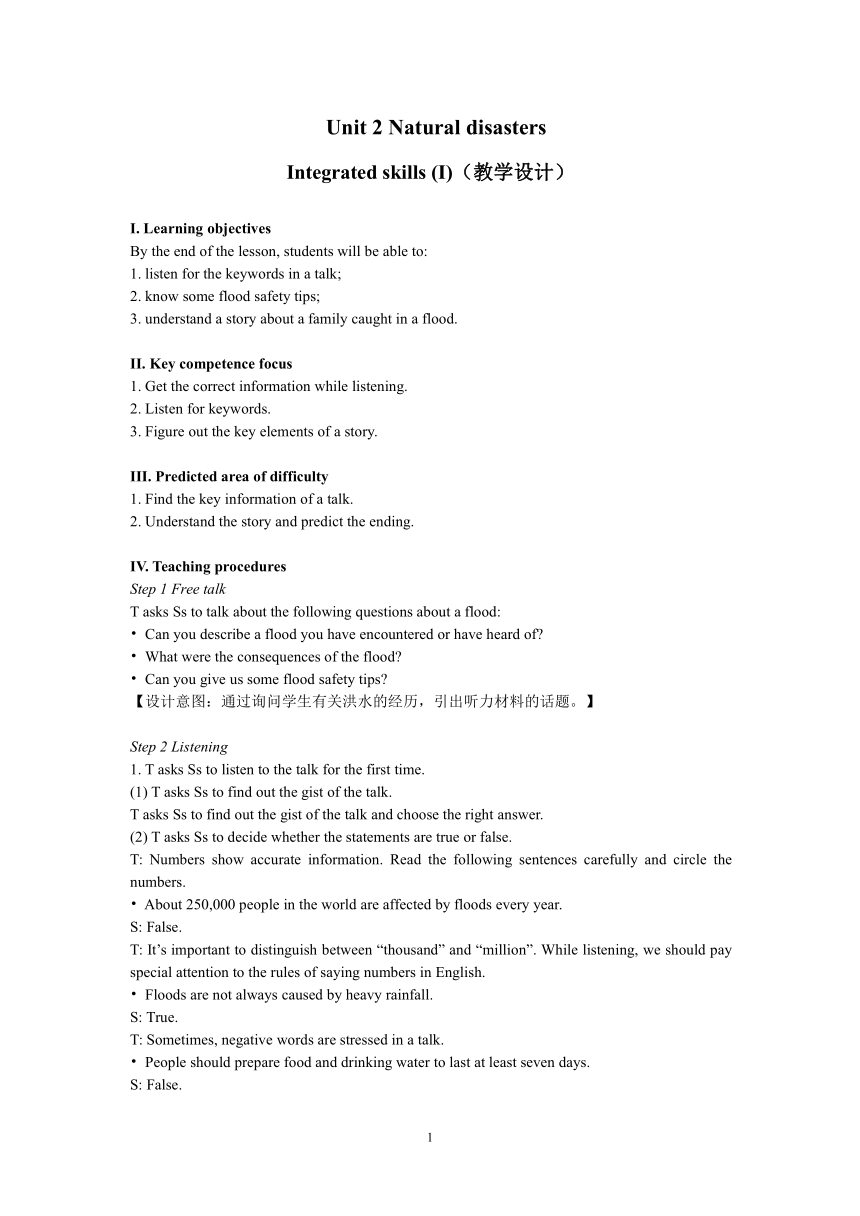
Unit 2 Natural disasters Integrated skills (I)(教学设计) I. Learning objectives By the end of the lesson, students will be able to: 1. listen for the keywords in a talk; 2. know some flood safety tips; 3. understand a story about a family caught in a flood. II. Key competence focus 1. Get the correct information while listening. 2. Listen for keywords. 3. Figure out the key elements of a story. III. Predicted area of difficulty 1. Find the key information of a talk. 2. Understand the story and predict the ending. IV. Teaching procedures Step 1 Free talk T asks Ss to talk about the following questions about a flood: Can you describe a flood you have encountered or have heard of What were the consequences of the flood Can you give us some flood safety tips 【设计意图:通过询问学生有关洪水的经历,引出听力材料的话题。】 Step 2 Listening 1. T asks Ss to listen to the talk for the first time. (1) T asks Ss to find out the gist of the talk. T asks Ss to find out the gist of the talk and choose the right answer. (2) T asks Ss to decide whether the statements are true or false. T: Numbers show accurate information. Read the following sentences carefully and circle the numbers. About 250,000 people in the world are affected by floods every year. S: False. T: It’s important to distinguish between “thousand” and “million”. While listening, we should pay special attention to the rules of saying numbers in English. Floods are not always caused by heavy rainfall. S: True. T: Sometimes, negative words are stressed in a talk. People should prepare food and drinking water to last at least seven days. S: False. T: Listen to the number carefully. As for “seven” and “three”, the pronunciations of “s” and “th” sound similar, which may confuse you. Fifteen centimetres of moving water can wash most cars away. S: False. T: There are two ways to correct the sentence. What are they S: 60 centimetres of moving water can wash most cars away, or 15 centimetres of moving water can knock an adult down. 【设计意图:指导学生先仔细阅读题干,圈出关键信息,然后通过听录音辨析正误。尤其要让学生关注录音中数字的读法,区分易混淆的音,避免信息张冠李戴。】 (3) T asks Ss to paraphrase the phrases. T asks Ss to to replace the phrases in part A with the words in the talk. in the world: worldwide every year: annually not always: usually food and drinking water: disaster supplies 【设计意图:培养学生在听力过程中“同义替换”的能力。】 2. T asks Ss to listen to the talk for the second time. (1) T gives Ss some tips on listening for keywords. T: It is important to listen for keywords carefully. Keywords are the most important words in a sentence or paragraph. They are often stressed and repeated. There is usually a pause before a keyword. (2) T explains how to use keywords by two examples. T: The questions in listening often contain two types of words: those likely to be used by the speaker and those likely to be paraphrased. Identifying the “anchor” words (names, numbers, dates, ... ...
~~ 您好,已阅读到文档的结尾了 ~~

